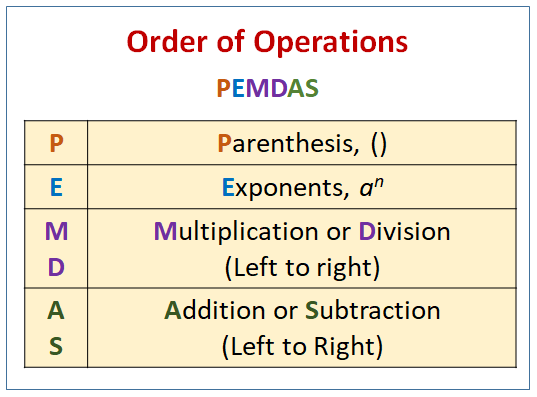In these lessons, we will learn the PEMDAS rule for the order of operations. PEMDAS is the acronym for Parenthesis, Exponents, Multiplication, Addition and Subtraction. It is used to help you remember the order of operations.
What Is The PEMDAS Rule?
If the expression consists of parenthesis, exponents, +, –, × and ÷, then the operations MUST be performed in the following order.
- Always work on the calculations within parenthesis first if any.
- Next, calculate the exponents.
- Then, carry out multiplication or division, working from left to right.
- Lastly, do addition or subtraction, working from left to right.

The following figure shows the PEMDAS order of operations. Scroll down the page for more examples and solutions on how to use the PEMDAS rule for order of operations.
The order to perform combined operations is called the PEMDAS rule.
Note: Another way to remember PEMDAS is to remember the phrase
Please Excuse My Dear Aunt Sally.
Example:
Evaluate 10 ÷ 2 + 12 ÷ 2 × 3
Solution:
Using the PEMDAS rule, we need to evaluate the division and multiplication before subtraction and addition. It is recommended that you put in parenthesis to remind yourself the order of operation.
10 ÷ 2 + 12 ÷ 2 × 3
= (10 ÷ 2) + (12 ÷ 2 × 3)
= 5 + 18
= 23
How does PEMDAS work?
The following videos show more examples of the application of PEMDAS.
Example:
7 + 3 × 5 =
7 + 3 × 4 ÷ 2 − 5 × 6 =
How to solve order of operations problems?
A more complicated example for the order of operations.
Example:
7 × 2 + (7 + 3 × (5 − 2)) − 4 × 2 =
Order of Operations (PEMDAS)
Examples:
3 + 4 × 5 =
4 × 32 =
[4 − 1 + (5 + 3)] =
15 − 12 × 2/(12/3) + 22=
(2 + 6)/4 × 3
PEMDAS Song (with lesson) order of operations
Examples:
5 × 3 + 5 =
4 + 52 – 2 × (6 ÷ 2)
How to use the PEMDAS rule
Learn one of the most important rules of math: the order of operations, also known as the PEMDAS rule.
Examples:
32 + (8 − 3) × 4 =
8 + 2 × 4 =
24 − 8 × (2 + 3)
3(5 + 8) – 22/4 + 3
39 – 4/4 + 3
Leave a Reply